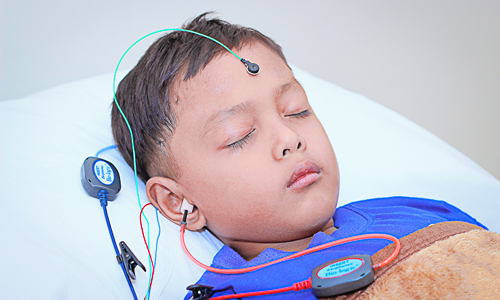Bera Test
BERA (Brainstem Evoked Response Audiometry) Test is an otoneurological test that examines brain function and auditory function in response to the sound stimulus. Later, only the interpretation and the testing of the result is carried out by the audiology specialist in Otorhinolaryngology. BERA test makes it possible to estimate the rate of passage of the nerve impulse through the auditory nerve. After that, the analysis of the test takes about an hour.
It is an impartial way of eliciting brain stem potentials in response to audiological click stimuli. In this method, electrodes are placed in the scalps which produce waves. It is used for the newborn hearing screening, auditory screening threshold, intraoperative monitoring, determine hearing loss type and its intensity, auditory nerve and brainstem lesion detection, and for the development of cochlear implants. This process is risk-free and not painful.

The Brainstem Evoked Response Audiometry (BERA)Test: also called the ABR test or the BSER test is an objective test of hearing that is traditionally used for testing the structural and functional integrity of the auditory pathway from the inner ear to the midbrain. Many neurotological disorders that present with vertigo or deafness have defects in this portion of the auditory pathway in the brain. This is hence one of the basic investigations in patients suffering from vertigo, imbalance, hearing deficit and tinnitus. The test is also used to determine the degree of hearing loss objectivity in pediatric patients as well as in difficult to test patients who do not respond reliably to the subjective tests of hearing like the pure tone audiometry and allied tests.

In medical parlance this test is an auditory evoked potential test. When a auditory stimulus (sound) is presented to the ear, an electrical potential is evoked in the cochlea in response to the sound stimulus and this electrical output called ‘action potential’ traverses through the auditory pathway to reach the higher areas in the brain where it is processed and the meaning pertaining to the sound interpreted. The BERA test monitors and records the smooth passage of the electrical impulse through a major part of the brain. In disorders of the brain involving the auditory pathway, the smoothness of the passage of this electrical impulse gets affected and this abnormality can be picked up by the BERA test. The response is identified by peaks (also called waves) that occur typically between one and ten millisecs from the onset of the sound stimulus. The BERA peaks are measured and marked traditionally as waves one, two, three, four, and five; each wave has an expected latency (time in millisecs between the presentation of the sound and the occurrence of the wave peak) which is considered as normal and any increase of the latency or absence of any of the wave / peaks indicates an abnormality in the auditory track i.e., the nerves (neural pathways) that transmit the electrical potential in the brain. By analyzing the morphology of the BERA graph and by measuring different parameters of the wave peaks in the graph (as shown in Fig B1), clinicians with sufficient knowledge and insight on the intricacies of BERA can identify disorders in the portion of the brain through which the auditory track passes as it traverses from the ear to a portion high up in the brain called the midbrain. Since a big portion of the neural pathway that connects the balance organ situated deep inside the ear to the higher levels in the brain also traverses along the same pathway as the auditory pathway, BERA though primarily a test of the hearing system, is a very important test for patients suffering from balance disorders like vertigo / imbalance.
Methodology
Handsets are used to hear different sounds. It measures the change in electrical activity (EEA) in the brain, in the emission of acoustic stimuli. The electrodes placed on the scalp i.e. on the surface of the head to the area behind the ear and forehead are used to create the electrical potentials in the auditory pathway. These electrical potentials are later recorded in the first ten milliseconds after the sound stimulations. These findings later explained on the basis of waves, which are received by the device. BERA test does not depend on the patients association. It is performed in a lying position. For children, rarely anesthesia is used. Sometimes it is performed while awake, by sedation or when in natural sleep.
Uses of BERA Test
- Evaluating case of deafness.
- Screening newborn for deafness.
- Intra-operative monitoring for the central nervous system.
Use for newborn
- Head injury
- Exposure to Ototoxic drugs
- Babies of low standard weight at the time of birth
- Hearing loss.
- Concern for parents about hearing levels in their children
We have the facility of Bera Test in Prayagraj.For consultation and treatment,
Contact Us:
33/29, Lowther Road George Town
Prayagraj, Near Sarodaya ENT Center
Phone: 7704889513, 9451889513
 help
help
